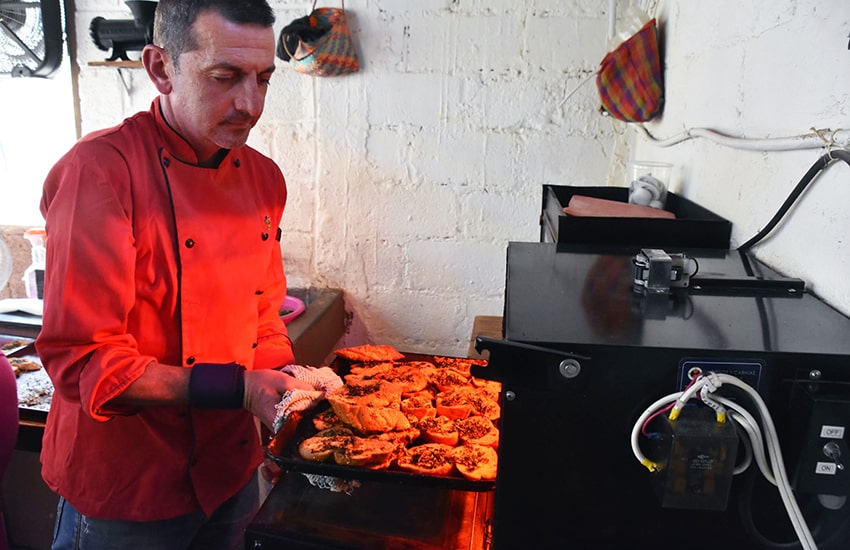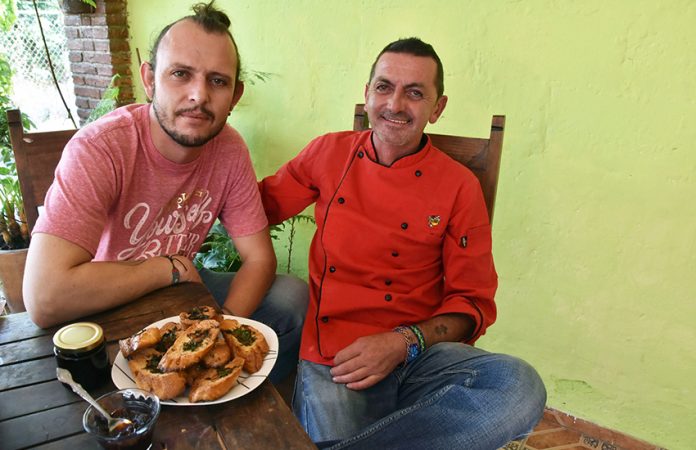A pair of cousins are well on their way to cornering the artisanal salsa and salad dressing market in Chipilo, Cholula, Puebla and several other Mexican cities.
Before starting their own businesses, César Galeazzi Bortolotti and Antonio (Pichi) Zechinelli Galeazzi had extensive experience in the food industry. Galeazzi worked as a cook for 12 years, while Zechinelli managed a restaurant and ran a store that sold artisanal foods.
Then they struck out on their own. Galeazzi decided to start his business, Macumba Salsa, after a meal in a restaurant.
“Many years ago, I tried a salsa in a restaurant that I liked a lot but could not find anywhere,” he said. “After several years, I decided to try to make my own.”
In 2012, Galeazzi started experimenting with his first salsa, which was made with carrots.

“I just tried with different ingredients,” he explained, “a little more of this, a little less of that. I started giving some to friends to try. When I started, I gave bottles as presents, I sold maybe one box a week.”
He started Macumba Salsas in 2014 and it has grown substantially from that one box a week. He figures he now delivers 100 to 120 boxes a week just in the state of Puebla. Another 50 go to Mexico City.
Galeazzi makes his salsas three days a week in a small, cramped building behind his house in Atlixco, Puebla, assisted at times by Ana Elsa Precoma. All of the salsas are handmade, a labor-intensive process.
Precoma cleans and cuts carrots while Galeazzi measures out various ingredients. He’s been making his salsas for so long, he no longer needs to consult the recipes.
After blending the ingredients for several minutes, Galeazzi poured the liquid into a squirt bottle and then filled small bottles with the salsa. He recently bought a machine that can fill 1,200 bottles an hour but for now, he still does it by hand.
“It is más rustico (more rustic),” he said.
He has five salsa flavors: carrot, cucumber, onion, mango and garlic with beets and they are all made with habañero chiles, mainly from Yucatán and Campeche, giving the salsas a serious kick; a small drop goes a long way. His salsas can be added to a variety of foods.
“Carrot and cucumber are good on salads, pastas and seafood,” he said. “Onion and the garlic with beets are used on meats — these are strong — and mango because it is sweet, good on salads and with shrimp. All of the salsas have the same base but different fruits or vegetables … I may start making strawberry, maybe tangerine later when I have more people working.”
He may also begin selling pesto and another salsa called salsa macho, a fiery concoction of sesame seeds, peanuts and chile de arbol.
Galeazzi uses habañeros in his salsas because “they do not bother the stomach.” They are also high in Vitamins A and C, he points out, and have been shown to lower cholesterol and blood pressure. They may even help to prevent some cancers.
Macumba seems to be an unusual name for a Mexican salsa since it’s the name of a religion primarily practiced in Brazil by people of African descent, a religion that is sometimes thought to be some type of witchcraft. Galeazzi said he learned about Macumba from Christian Zacek, a Cholulan painter and muralist. He said he liked the name and the fact it was a folk religion. His salsa, he said, is “el brujo de sabor” (the sorcerer of flavor).
Meanwhile, Zechinelli, Galeazzi’s cousin, lives and works about 15 minutes away on the outskirts of Chipilo. Like Galeazzi, his workspace is part of his home. He uses two rooms as kitchens to prepare his products. The first food he started making was crostini, toasted pieces of bread topped with parsley and garlic.
The idea to make crostini came to Zechinelli when he was leafing through a book.
“A long time ago, I saw a photo of crostini in a book and thought, ‘That looks interesting.” He was managing a store when he began making it. When he realized more and more people were buying his crostini, he decided to close the store and devote himself full-time to his own business, one that is a family affair.
In a room with two ovens, three women — all related in some way — prepare the crostini. Claudia slices the rolls; they’ll go through 1,000 every two days.
Across from her, Mariana ladles on the garlic while Alondra keeps an eye on the bread as it toasts. Zechinelli himself tops the slices with a generous dose of parsley. Once the slices are prepped, they go into a conventional oven.
“The bread is first toasted in a conventional oven for five minutes to toast the bottom,” Zechinelli said, “then in a commercial oven for 15 minutes.” It’s one he built himself.
Once the slices cool, they’re bagged and sealed. Each bag contains about 150 grams of crostini, about two rolls’ worth.

Crostini are often used to make bruschetta, which typically feature diced tomatoes, basil and other herbs piled atop the bread. But they can also be eaten plain, which is the way Zechinelli’s cockatiel, Fabrizio, likes them.
Zechinelli prepares his other two products, salad dressings and salsa macha, in an adjacent room.
He sells 14 different salad dressings, including poppyseed, the most popular, creamy Italian, and ranch. He churns out about 400 bottles every week and, like Galeazzi, does the work by hand.
Two years ago, Zechinelli began selling salsa macha, which packs a bit of a punch. He makes six different ones, all of them containing different chiles; sesame is the spiciest. They can be used to perk up meats or pastas but they’re also good slathered on his crostini and accompanied with an ice-cold beer. His crostini are sold in clear bags, and his salad dressings have their name tied to the bottle. The salsa macha come in small jars.
Zechinilli started his business six years ago and has yet to name it.
“I will not have a name for my products,” he said. “Everyone in Chipilo knows they are mine, that they are very homemade, that they are good. They say, ‘Oh, these are Pichi’s.’ They know the quality.”
The two cousins sell their products in stores and restaurants throughout Puebla, Morelos, Mexico City and as far away as Oaxaca and are especially well known in Chipilo, a small town in Puebla. When asked if they’d someday combine their businesses, Zechinelli replied, “In fact, we are one business already. He sells mine; I sell his. All of Chipilo is one business. We all sell each other’s products.”
Galeazzi’s salsas can be purchased online, but Zechinelli doesn’t have a website.
Just look for crostini in clear plastic bags and small bottles of dressing with a name tied to them.
Joseph Sorrentino, a writer, photographer and author of the book San Gregorio Atlapulco: Cosmvisiones and of Stinky Island Tales: Some Stories from an Italian-American Childhood, is a regular contributor to Mexico News Daily. More examples of his photographs and links to other articles may be found at www.sorrentinophotography.com He currently lives in Chipilo, Puebla.
